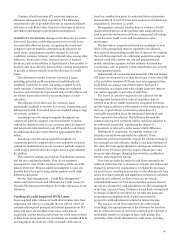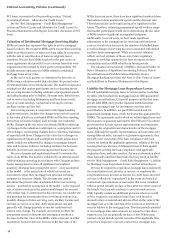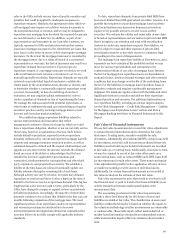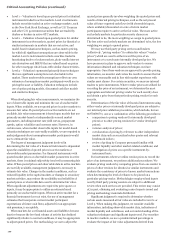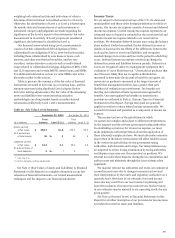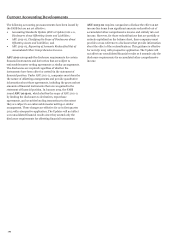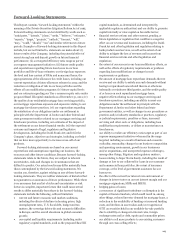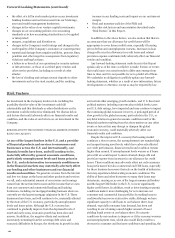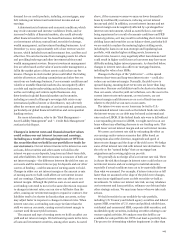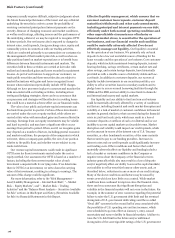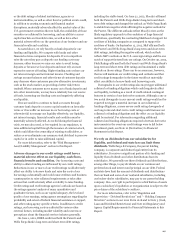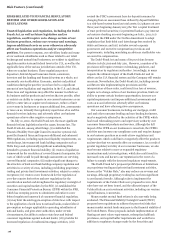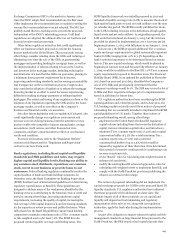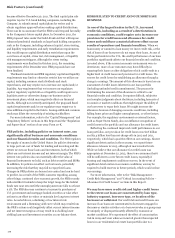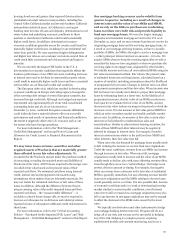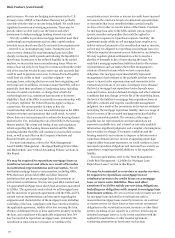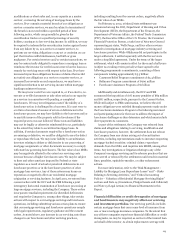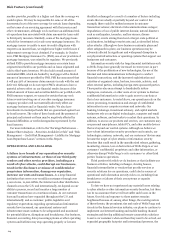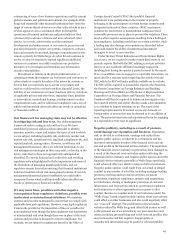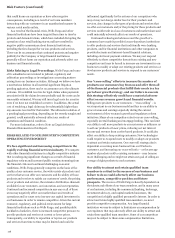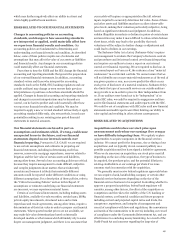Wells Fargo 2012 Annual Report Download - page 109
Download and view the complete annual report
Please find page 109 of the 2012 Wells Fargo annual report below. You can navigate through the pages in the report by either clicking on the pages listed below, or by using the keyword search tool below to find specific information within the annual report.or the debt ratings of related institutions, agencies or
instrumentalities, as well as other fiscal or political events could,
in addition to causing economic and financial market
disruptions, materially adversely affect the market value of the
U.S. government securities that we hold, the availability of those
securities as collateral for borrowing, and our ability to access
capital markets on favorable terms, as well as have other
material adverse effects on the operation of our business and our
financial results and condition.
As noted above, we rely heavily on bank deposits for our
funding and liquidity. We compete with banks and other
financial services companies for deposits. If our competitors
raise the rates they pay on deposits our funding costs may
increase, either because we raise our rates to avoid losing
deposits or because we lose deposits and must rely on more
expensive sources of funding. Higher funding costs reduce our
net interest margin and net interest income. Checking and
savings account balances and other forms of customer deposits
may decrease when customers perceive alternative investments,
such as the stock market, as providing a better risk/return
tradeoff. When customers move money out of bank deposits and
into other investments, we may lose a relatively low cost source
of funds, increasing our funding costs and negatively affecting
our liquidity.
If we are unable to continue to fund our assets through
customer bank deposits or access capital markets on favorable
terms or if we suffer an increase in our borrowing costs or
otherwise fail to manage our liquidity effectively, our liquidity,
net interest margin, financial results and condition may be
materially adversely affected. As we did during the financial
crisis, we may also need, or be required by our regulators, to
raise additional capital through the issuance of common stock,
which could dilute the ownership of existing stockholders, or
reduce or even eliminate our common stock dividend to preserve
capital or in order to raise additional capital.
For more information, refer to the “Risk Management –
Asset/Liability Management” section in this Report.
Adverse changes in our credit ratings could have a
material adverse effect on our liquidity, cash flows,
financial results and condition. Our borrowing costs and
ability to obtain funding are influenced by our credit ratings.
Reductions in one or more of our credit ratings could adversely
affect our ability to borrow funds and raise the costs of our
borrowings substantially and could cause creditors and business
counterparties to raise collateral requirements or take other
actions that could adversely affect our ability to raise funding.
Credit ratings and credit ratings agencies’ outlooks are based on
the ratings agencies’ analysis of many quantitative and
qualitative factors, such as our capital adequacy, the level and
quality of our earnings, rating agency assumptions regarding the
probability and extent of federal financial assistance or support,
and other rating agency specific criteria. In addition to credit
ratings, our borrowing costs are affected by various other
external factors, including market volatility and concerns or
perceptions about the financial services industry generally.
On June 1, 2012, DBRS confirmed both the Parent’s and
Wells Fargo Bank’s long-term and short-term debt ratings,
including the stable trend. On June 22, 2012, Moody’s affirmed
both the Parent’s and Wells Fargo Bank’s long-term and short-
term debt ratings and changed the outlook on Wells Fargo Bank
to stable from negative while affirming the negative outlook for
the Parent. The different outlooks reflect Moody’s view on the
likely regulatory approach to the resolution of large financial
institutions, specifically the contrasting likelihood of support for
creditors of holding companies as compared to support for
creditors of banks. On September 12, 2012, S&P affirmed both
the Parent's and Wells Fargo Bank’s long-term and short-term
debt ratings, including the negative outlook, which outlook
reflects S&P’s outlook on the U.S. sovereign ratings and the one
notch of support factored into our ratings. On October 30, 2012,
Fitch Ratings affirmed both the Parent’s and Wells Fargo Bank’s
long-term and short-term debt ratings and maintained a stable
outlook on those ratings. There can be no assurance, however,
that we will maintain our credit ratings and outlooks and that
credit ratings downgrades in the future would not materially
affect our ability to borrow funds and borrowing costs.
Downgrades in our credit ratings also may trigger additional
collateral or funding obligations which could negatively affect
our liquidity, including as a result of credit-related contingent
features in certain of our derivative contracts. Although a one or
two notch downgrade in our current credit ratings would not be
expected to trigger a material increase in our collateral or
funding obligations, a more severe credit rating downgrade of
our long-term and short-term credit ratings could increase our
collateral or funding obligations and the effect on our liquidity
could be material. For information regarding additional
collateral and funding obligations required of certain derivative
instruments in the event our credit ratings were to fall below
investment grade, see Note 16 (Derivatives) to Financial
Statements in this Report.
We rely on dividends from our subsidiaries for
liquidity, and federal and state law can limit those
dividends. Wells Fargo & Company, the parent holding
company, is a separate and distinct legal entity from its
subsidiaries. It receives a significant portion of its funding and
liquidity from dividends and other distributions from its
subsidiaries. We generally use these dividends and distributions,
among other things, to pay dividends on our common and
preferred stock and interest and principal on our debt. Federal
and state laws limit the amount of dividends and distributions
that our bank and some of our nonbank subsidiaries, including
our broker-dealer subsidiaries, may pay to our parent holding
company. Also, our right to participate in a distribution of assets
upon a subsidiary’s liquidation or reorganization is subject to the
prior claims of the subsidiary’s creditors.
For more information, refer to the “Regulation and
Supervision – Dividend Restrictions” and “– Holding Company
Structure” sections in our 2012 Form 10-K and to Note 3 (Cash,
Loan and Dividend Restrictions) and Note 26 (Regulatory and
Agency Capital Requirements) to Financial Statements in this
Report.
107


